feature
Let's Build a Fast Car
Instantiating three-dimensional instruction through a STEAM planning guide
Science and Children—September/October 2021 (Volume 59, Issue 1)
By Pei-Ying Wu, Sharon Arias, and Jacqueline Hernandez
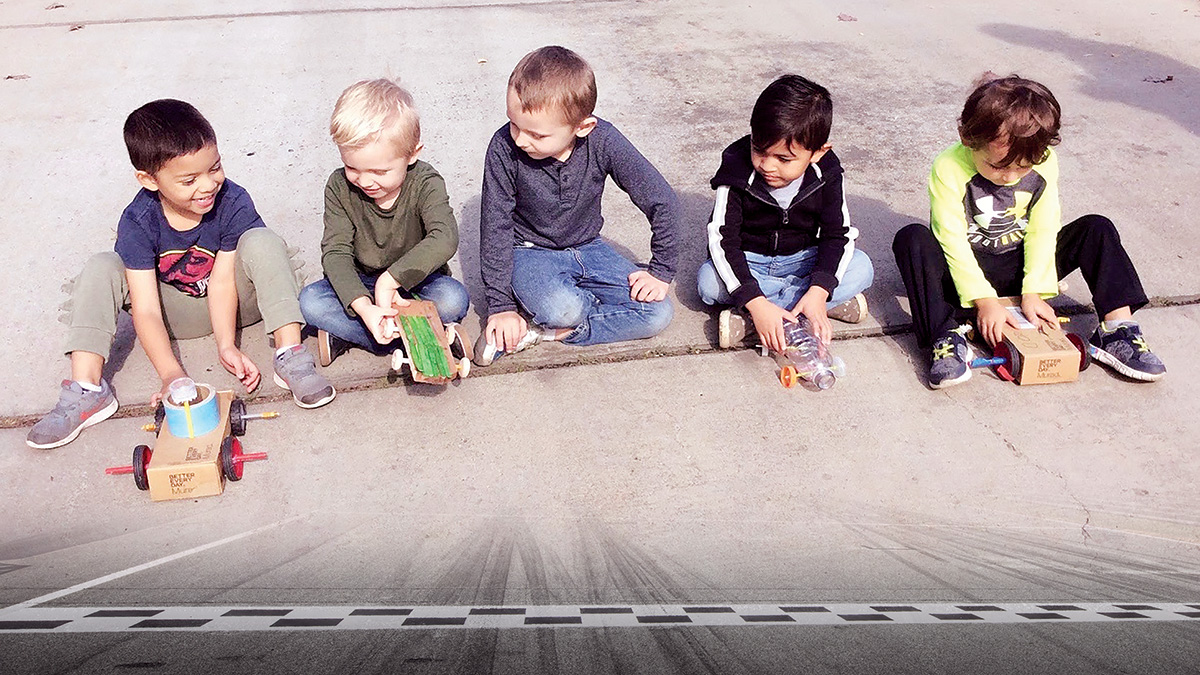
In the block area, two preschoolers, Lili and Russel, are searching through a box of Lego bricks to find ideal pieces for their constructions. “Look what I have found!” Lili dangles her discovery in front of Russel—a pair of wheels with a metal axle. “I am going to make the fastest car in the world,” Lili says, attaching the wheels to her creation and continuing to search for more pieces. Russel is intrigued by his friend’s new discovery and decides to change his design, too. “I am going to build a stronger, bigger, and faster car than yours,” Russel claims. “No, I found the wheels first so mine is the best,” Lili argues. The teachers notice that the conversation is getting heated and may turn into combative or disruptive behavior, so they decide to transform this competitive play into a developmentally appropriate, meaningful investigation. “Friends, do you know what makes car go fast? Do you want to test how fast your car can go?” the teacher proposed.
The teachers not only stepped in to provide emotional guidance but also saw an opportunity in the children’s serious feelings about winning in speed games. This was the backdrop that prompted the teachers to brainstorm possibilities to help develop positive learning experiences and outcomes.
Context
This project took place in fall 2019 and lasted for seven months in a preschool classroom consisting of a master teacher, teacher and assistants, and 21 children (ages 3–5) within a university-based early childhood education center that serves children from birth through six years old. The center’s philosophy is influenced by the Reggio Emilia approach from Italy, in which educational projects are considered one of its essential dimensions. Teachers and children are researchers who ask questions, conduct experiments, observe and collect data, analyze results, and raise new questions (Reggio Children 2010).
The teachers began the inquiry, embarking on a speed project in the classroom and using a planning tool developed based on years of project work experience with young children (Arias and Abramson 2018), the study of research on early childhood education science curricula, and on Reggio-inspired philosophy. This planning tool is called the Science, Technology, Engineering, Arts, and Mathematics (STEAM) Planning Guide (the Guide here after) (Figure 1). The Arts are seen as “activators of learning” that awaken young children’s sensibility and ability for connecting disparate knowledge. They provide different ways for children to “represent, communicate, and express their thinking in different media and symbolic systems” (Vecchi 2010, pp. 8–9).

The Guide can help early educators expand children’s scientific interests and concepts from spontaneous play and select possible directions worthy of in-depth investigations. The Guide provides a framework of learning experiences at four levels:
- Level 1: A catalyzing event or experience that provokes scientific interests and curiosity and can take many forms, such as a provocation or a spontaneous play activity. It can be initiated by teachers or children.
- Level 2: Experimenting that involves testing activities that follow some rules in an attempt to make predictions, answer questions, make certain observations, or find new questions.
- Level 3: Designing Models, an opportunity for children to represent ideas and theories that describe how science and engineering work. Teachers select children’s questions or problems of common interest that have potential to contribute to their growing understanding of important scientific or engineering aspects. Guided by provocative questions teachers provide materials or media and support them to create working models, such as physical structures or conceptual drawings. They engage children in applying different solutions, answering questions, testing theories or evaluating competing models. Teachers can also lead children to revise, improve, and reflect on their models.
- Level 4: Solving real-world problems is based on the knowledge and skills that children developed during the levels of experimenting and modeling. Teachers and children collaboratively decide the problem that they want to solve. Once the problem is identified, teachers and children will research possible solutions, including consulting with experts, searching online, or taking field trips. Children will eventually select and present solution(s) with others to demonstrate what they learned.
The use of the Guide begins with close observational practices to discern interests, dispositions, and capabilities of individual group members. These observations reveal possible project directions for teachers to engage children in investigating phenomena or designing solutions to problems. The levels of the Guide are used to provide both common and specific science and engineering experiences for the children, developing interest, engagement, and persistence and contributing to the growth of scientific knowledge, skills, and dispositions. The four different levels of the Guide have distinct levels of rigor, from the more open-ended catalyzing events to more structured real-world problem solving. The sequence of the four levels does not have to be chronological. Based on the need and the dynamic of the class, the teacher can provide different levels of learning experience iteratively. Using this guide, teachers can conceptualize and plan science and engineering explorations and investigations from simple to more complex. These scaffolded activities will provide children opportunities to apply the crosscutting concepts and deepen their understanding of core ideas across disciplines.
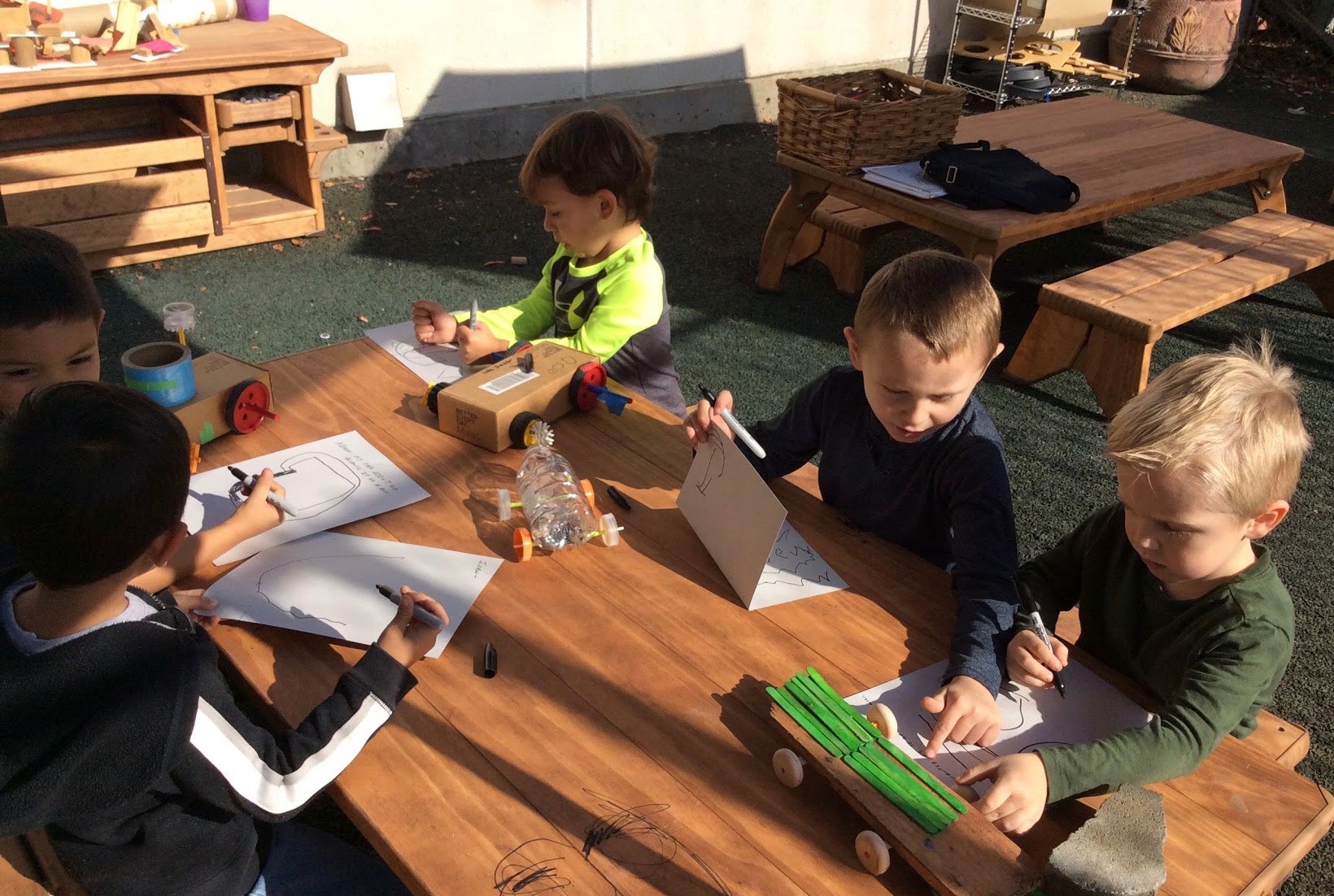
Level 1: A Catalyzing Event
With the backdrop described above, the teachers propose a provocation as the catalyzing experience: Build a really fast car! Children were offered loose parts (e.g., cans, rollers, tape, old toy cart parts, random manipulatives, craft supplies) to build cars in small groups in an outdoor maker space.
As children actively engaged in building their own fast cars, meaningful questions emerged, such as “Why doesn’t my car move?” and “How do I make my car go fast?” These engineering questions prompted the teacher to provide additional catalyzing experiences—playing with ramps to provoke children’s scientific interests and curiosity around motion and speed. As the teachers closely observed children’s positive energy and interests in catalyst events, they also formed research questions for themselves: “What do the children know about speed?” and “What do the children know about cars and car parts?” They decided to provide relevant experimental opportunities for children to investigate and make sense of forces and motion.
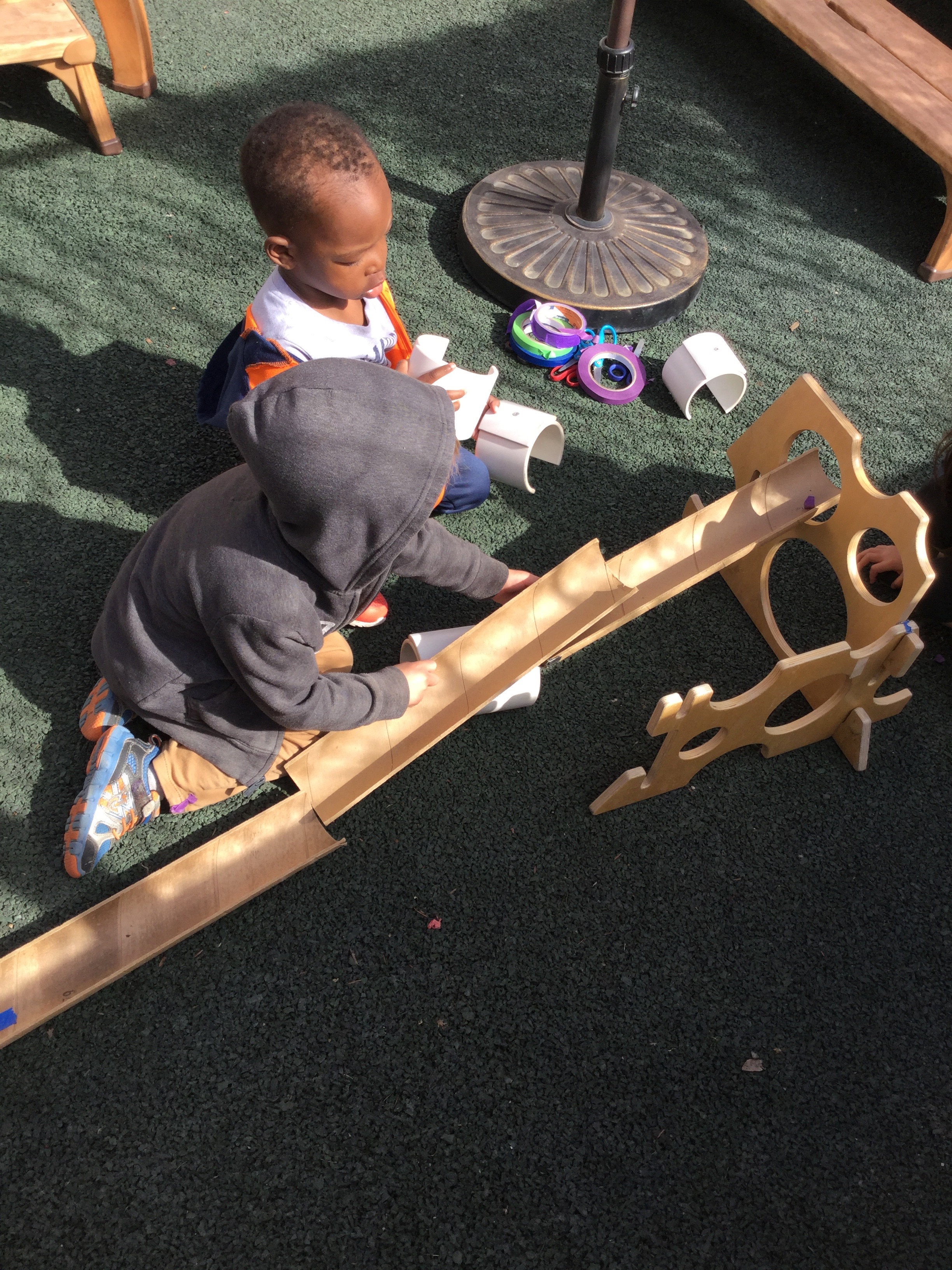
Level 2: Experimenting
To facilitate experimentation, the teachers posed the questions “What is speed?” and “What makes things go fast?” to the children and led them to conduct a series of investigations about force and motion with ramps. The teachers provided balls of different sizes and textures for the children to roll down a variety of ramps; some were made using loose part ramp pieces or recycled cardboard pieces; others were ramps outdoors, such as a slide, and a downhill driveway. Different incline, size, weight, and friction were investigated. These intentionally designed experiments provided creative, inquisitive young scientists valuable opportunities to strengthen the concept of cause and effect and reveal emerging skills in observing, hypothesizing, predicting, questioning, and classifying. Children did observational drawings that showed the results of their experiments and explained their understanding of the effects of gravity and weight on speed. Children’s comments included “It’s bigger and faster,” “It’s up there. It’s higher, and makes the balls go faster,” “It went faster cause it was heavier,” and “It went straighter, and it was faster.” The teachers also engaged the children in analyzing results by making charts to document the results in terms of incline, weight, friction, and size.
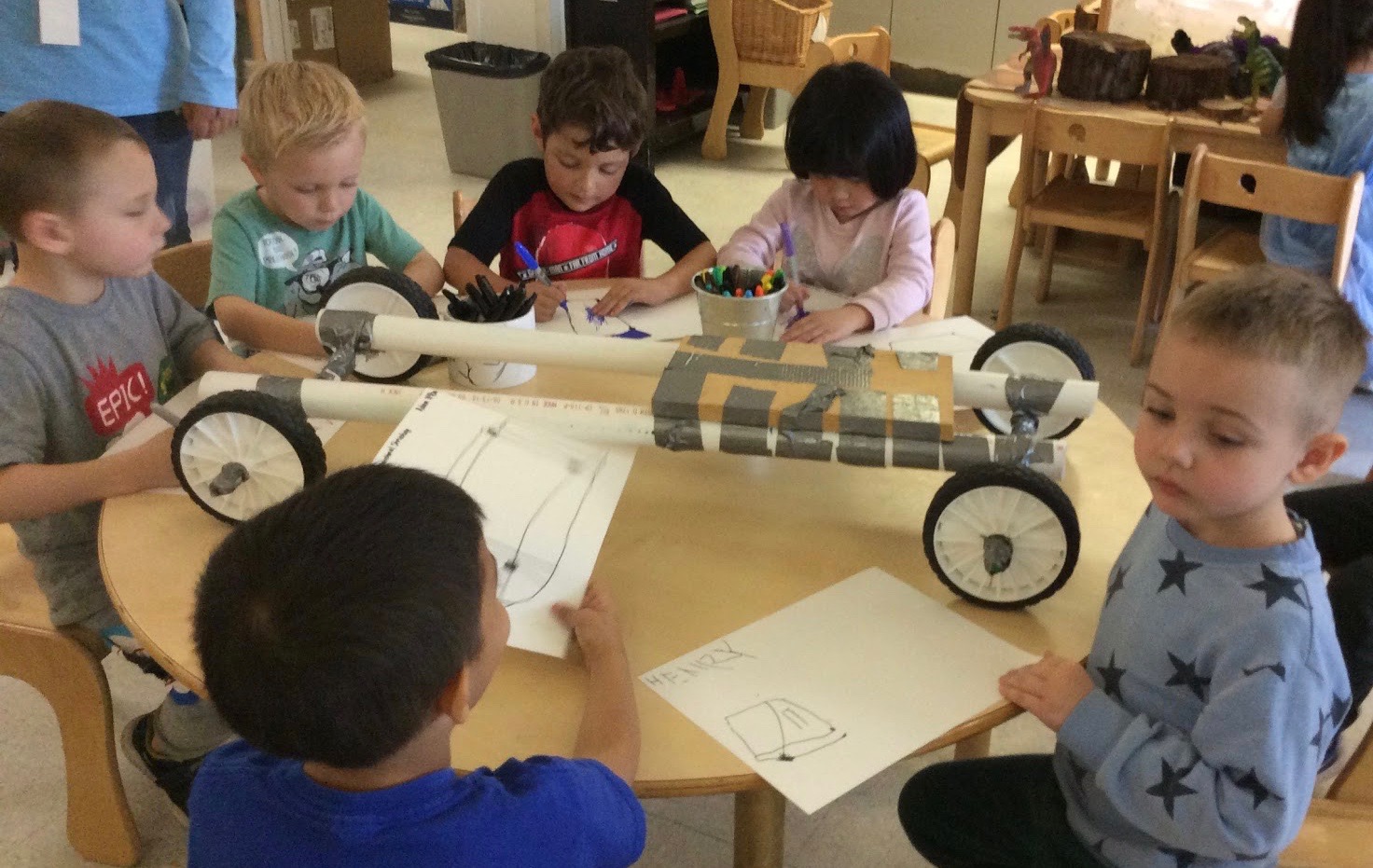
Level 3: Designing Models
With newly learned knowledge from a series of investigations, the children were inspired to make cars that move fast. The teachers continued to research with the children by reading stories, looking at models on the internet, watching videos online, and drawing models for cars. Through research, the children learned new concepts and academic vocabulary that they began to use in their spontaneous conversations: axle, engine, steering wheel, drive shaft, windshield, seatbelt. The children developed theories, describing in great detail what their cars were able to do and what made them go fast. At this stage, the teachers offered materials that are stronger for model making, such as small metal rods and PVC pipe fittings. Parents were also involved to make axles and wheels for cars, so that the children had the important components to make moving cars.
As the children were making new, improved models, the teachers read If I Built a Car by Chris Van Dusen (2005) to the children. This prompted them to build two cars with varying weight and size characteristics for the purpose of studying the questions of incline and size in closer detail and to propose ideas, present theories, explain phenomena or predict results with fewer variables.
The two new models were made out of identical, very sturdy cardboard boxes, approximately 20 inches by 10 inches. By this time, some of the older children knew how to design wheels and axles using PVC pipe, round attachments, and duct tape, and they taught the others how to do it. The children were offered loose parts, such as rocks, tape, cardboard scraps, small wood bits, and fabric to make one car much heavier than the other, and one much bigger. These two cars were also raced and recorded. The model construction process supported children to elaborate on or modify their initial ideas about speed, size, weight, friction, and incline, and it offered a planning opportunity for a more complex car design.
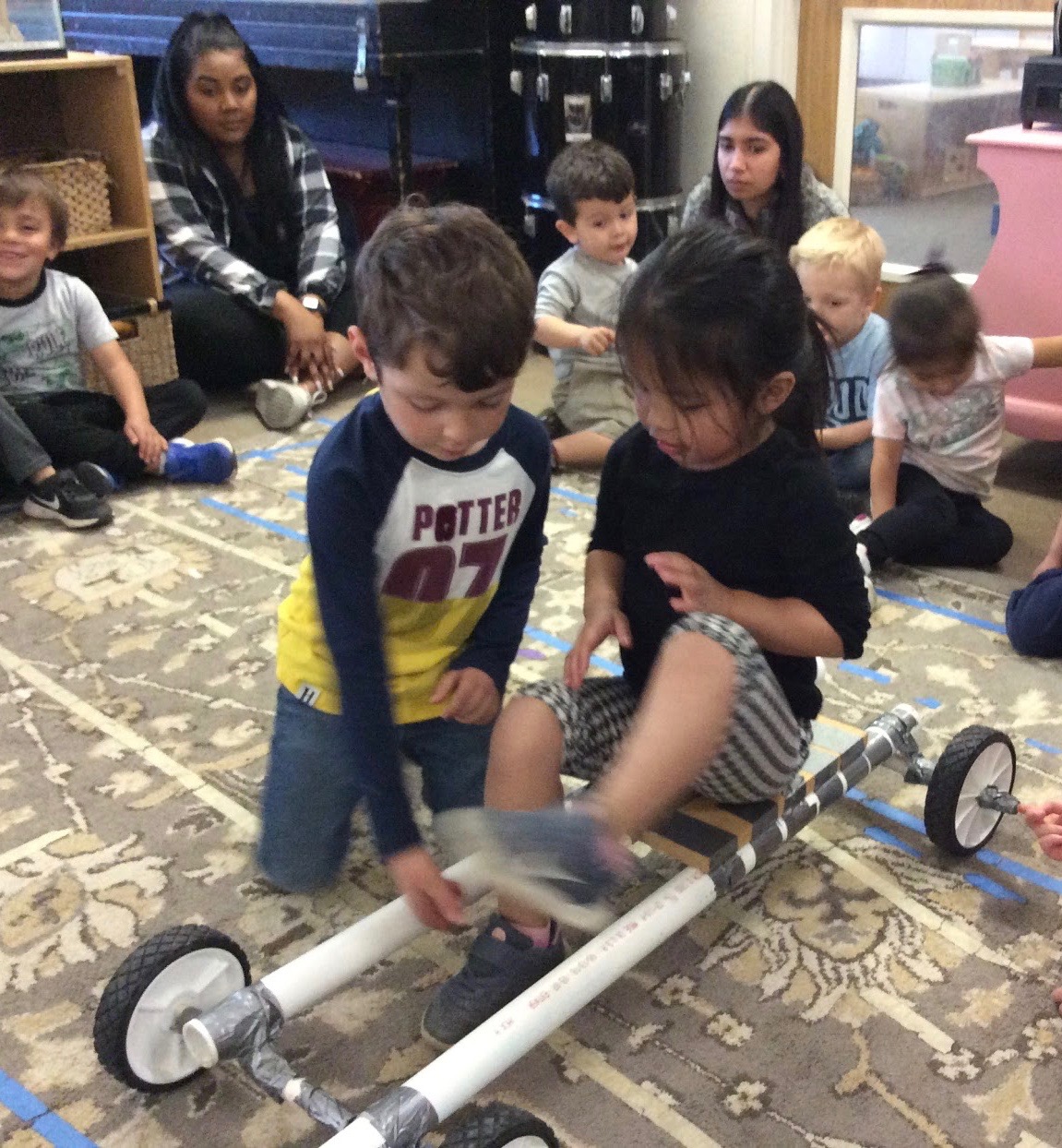
Level 4: Real-Life Problems
Building upon the knowledge and skills developed during the levels of experimenting and modeling, the children expressed strong interest in building a car that they could ride on. Although the children had firsthand engineering experience with axles and wheels on small models, the teachers saw the needs of supporting the children to investigate possible designs of larger models by consulting with experts, searching online, and taking field trips. Through research, the children learned that there are different models of small ride-on cars for children and saw a video of a PVC pipe go-cart, which later became the model they voted on to build.
Applying the concepts and skills from research and model-making, the children designed and built the first go-cart that they could ride by using duct tape, PVC pipe, sand buckets, wheels, and wooden dowels. It worked but only temporarily because it kept breaking. This engineering problem gave the children an opportunity to re-examine their design and consider different solutions. Eventually, they successfully created a steady, movable go-cart that could support the weight of a child by optimizing the design of the axle, the frame, the PVC pipe structure, and wheels.
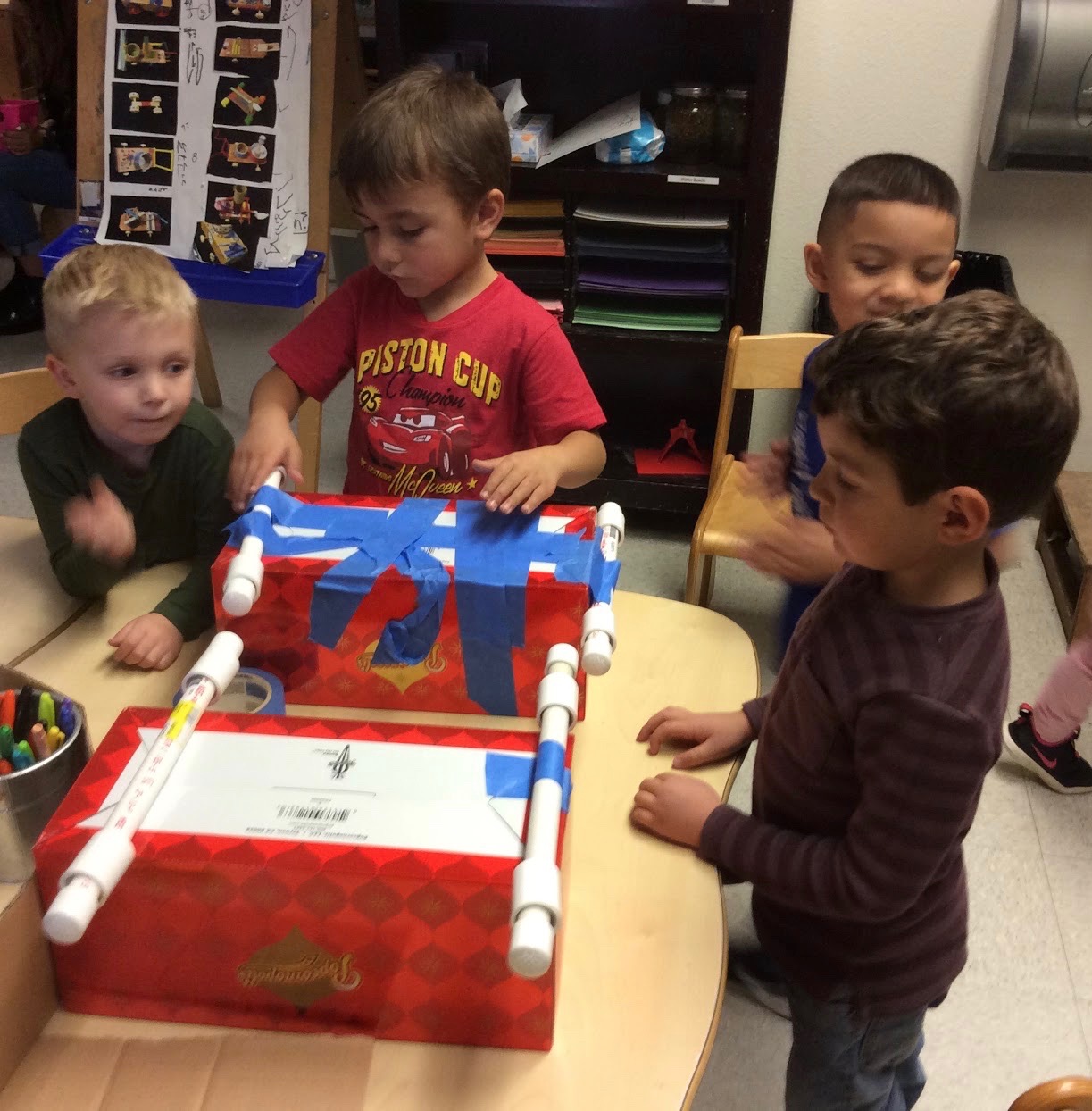
Assessment
In this project, the teachers used the Desired Result and Developmental Profile (DRDP), a formative assessment instrument developed by the California Department of Education, to assess the growth of the children’s behaviors, knowledge, and skills. By comparing pre- and post-DRDP group results over a seven-month project period, the teachers found that the children as a group showed gains in cognition, including math and science, and in social emotional development, especially in areas of identity and understanding of others’ perspectives. The teacher’s observational notes and anecdotal records also show that the children not only actively carried out investigation and documented and analyzed data from experiments, which strengthened their concept of cause and effect and their understanding about force and motion, but also utilized design thinking and developed engineering solutions.
Conclusion
Competent teachers easily identify topics that interest children, but the more challenging part is to move beyond interest and mild engagement to the pursuit of complex scientific and engineering knowledge, the application of crosscutting concepts, and the development of stronger problem solving and researching skills. Authentic evidence from this project demonstrates the uniqueness of the Guide, which allows the teachers to plan science and engineering practices systematically, to implement three-dimensional science instruction that progresses from informal, isolated, or discrete science activities to deeper, cohesive investigations, and to deepen children’s understanding of the world around them. ●
Resources
Dahl, M. 2006. Roll, slope, and slide: A book about ramps. Mankato/Minnesota: Picture Windows Books.
Dusen, C. 2005. If I built a car. New York: Penguin Young Readers Group.
Frazee, M. 2006. Roller coaster. New York: Voyager Books.
Graham, J. 2013. Hands on science: Forces and motion. New York: Kingfisher London and New York.
Litton, J. 2018. STEAM stories: The great go-cart race (Science). London: Quarto Publishing plc.
Shirley, C. 2018. Go-cart gertie. Woodstock/Georgia: Let’s Pretend Publishing LLC.
Online Resources
Let’s Get Rolling! Physics for Kids https://www.youtube.com/watch?v=YIV9IUHqW3A
Make a Balloon Car https://www.youtube.com/watch?v=RStgV8mA-gA
Make a pvc pipe go kart https://www.youtube.com/watch?v=U9cazC7DBFk&list=PLlnyVFJXV7M6mL7AP4Hrfk6ji9_b3AOG6
Homemade Wooden Go Kart https://www.youtube.com/watch?app=desktop&v=E81VUJAx-W8
Simple Machines – The Inclined Plane https://www.youtube.com/watch?v=5c4J_PW9wsg
Pei-Ying Wu (peiwu@mail.fresnostate.edu) is an assistant professor in the Department of Literacy, Early Childhood, Bilingual, and Special Education and the Fansler Chair of Joyce M. Huggins Early Education Center at California State University, Fresno. Sharon Arias is a Atelierista (studio teacher) at Programs for Children, California State University. Jacqueline Hernandez is a Master Teacher at Programs for Children, California State University.
Crosscutting Concepts Disciplinary Core Ideas Instructional Materials Interdisciplinary STEM Teaching Strategies Three-Dimensional Learning


